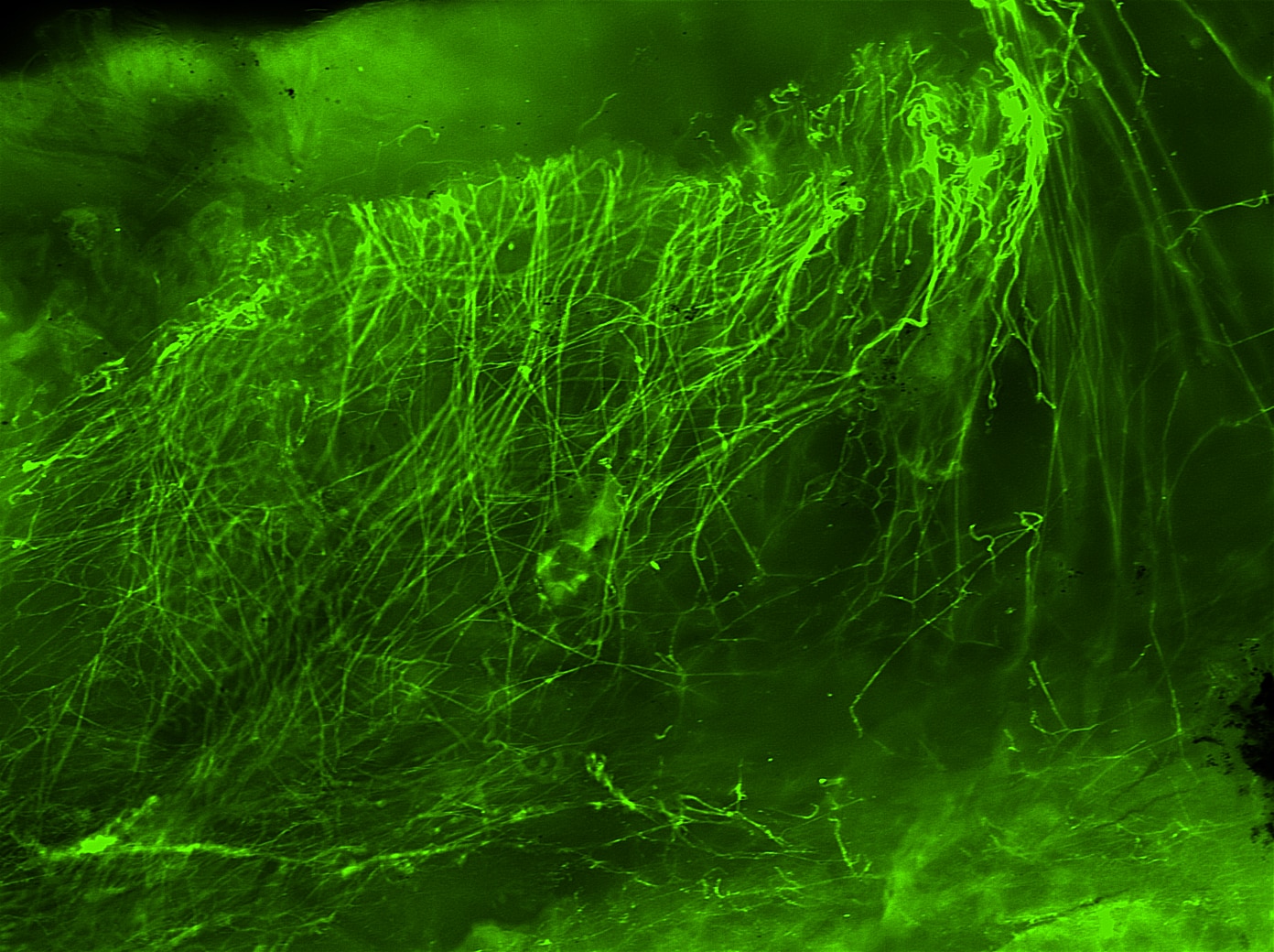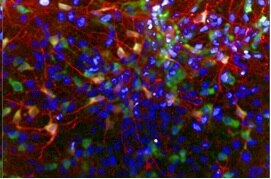Human/Mouse Tyrosine Hydroxylase Antibody Summary
Ala278-Tyr401
Accession # P07101
Applications
Please Note: Optimal dilutions should be determined by each laboratory for each application. General Protocols are available in the Technical Information section on our website.
Scientific Data
 View Larger
View Larger
Detection of Human, Mouse, and Rat Tyrosine Hydroxylase by Western Blot. Western blot shows lysates of human adrenal gland tissue, mouse adrenal gland tissue, and rat adrenal gland tissue. PVDF membrane was probed with 0.25 µg/mL of Mouse Anti-Human/Mouse Tyrosine Hydroxylase Monoclonal Antibody (Catalog # MAB7566) followed by HRP-conjugated Anti-Mouse IgG Secondary Antibody (Catalog # HAF018). Specific bands were detected for Tyrosine Hydroxylase at approximately 50-60 kDa (as indicated). This experiment was conducted under reducing conditions and using Immunoblot Buffer Group 1.
 View Larger
View Larger
Tyrosine Hydroxylase in Mouse Dopaminergic Neurons. Tyrosine Hydroxylase was detected in immersion fixed mouse embryonic stem cells differentiated into dopaminergic neurons using Mouse Anti-Human/Mouse Tyrosine Hydroxylase Monoclonal Antibody (Catalog # MAB7566) at 10 µg/mL for 3 hours at room temperature. Cells were stained using the Northern-Lights™ 557-conjugated Anti-Mouse IgG Secondary Antibody (red; Catalog # NL007). Cells were double stained using the Northern-Lights™ 637-conjugated Mouse Anti-Neuron-specific beta-III Tubulin Monoclonal Antibody (white; Catalog # NL1195V). Cells were counterstained with DAPI (blue). Specific staining of Tyrosine Hydroxylase was localized to cytoplasm of dopaminergic neurons. View our protocol for Fluorescent ICC Staining of Cells on Coverslips.
 View Larger
View Larger
Tyrosine Hydroxylase in Human Brain. Tyrosine Hydroxylase was detected in immersion fixed paraffin-embedded sections of human brain (medulla) using Mouse Anti-Human/Mouse Tyrosine Hydroxylase Monoclonal Antibody (Catalog # MAB7566) at 25 µg/mL overnight at 4 °C. Tissue was stained using the Anti-Mouse HRP-DAB Cell & Tissue Staining Kit (brown; Catalog # CTS002) and counterstained with hematoxylin (blue). Specific staining was localized to neurons. View our protocol for Chromogenic IHC Staining of Paraffin-embedded Tissue Sections.
 View Larger
View Larger
Detection of Human and Mouse Tyrosine Hydroxylase by Simple WesternTM. Simple Western lane view shows lysates of human adrenal gland tissue and mouse adrenal gland tissue, loaded at 0.2 mg/mL. Specific bands were detected for Tyrosine Hydroxylase at approximately 52-61 kDa (as indicated) using 5 µg/mL of Mouse Anti-Human/Mouse Tyrosine Hydroxylase Monoclonal Antibody (Catalog # MAB7566). This experiment was conducted under reducing conditions and using the 12-230 kDa separation system.Non-specific interaction with the 230 kDa Simple Western standard may be seen with this antibody.
Reconstitution Calculator
Preparation and Storage
- 12 months from date of receipt, -20 to -70 °C as supplied.
- 1 month, 2 to 8 °C under sterile conditions after reconstitution.
- 6 months, -20 to -70 °C under sterile conditions after reconstitution.
Background: Tyrosine Hydroxylase
TH (Tyrosine 3-hydroxylase), also known as Tyrosine 3-monooxygenase, is a 60-62 kDa member of the biopterin-dependent aromatic amino acid hydroxylase family of molecules. It is expressed by neurons of the dopamine and autonomic nervous system, plus the neuroendocrine cells of the adrenal medulla. TH is considered the rate limiting enzyme for catecholamine synthesis, and serves to catalyze the hydroxylation of L-tyrosine. It maintains stores of catecholamines following secretion, and its activity is regulated by targeted site phosphorylation. Human TH is 528 amino acids (aa) in length. It contains an N-terminal ACT domain (aa 69-190) that binds small molecules and regulates enzyme activity, and a C-terminal enzymatic region (aa 196-493). There are three significant utilized phosphorylation sites. Two at Ser31 and Ser40 increase enzyme activity, while phosphorylation at Ser19 promotes subsequent Ser40 phosphorylation. TH functions as a 240 kDa noncovalent homotetramer. There are four potential splice variants. One shows a deletion of aa 31-34, a second shows a deletion of aa 31-61, while a third contains a Met substitution for aa 1-34. A fourth isoform variant shows a deletion of aa 35-61. Over aa 278-401, human TH shares 94% aa sequence identity with mouse TH, a molecule that most closely resembles the fourth human isoform variant described above.
Product Datasheets
Citations for Human/Mouse Tyrosine Hydroxylase Antibody
R&D Systems personnel manually curate a database that contains references using R&D Systems products. The data collected includes not only links to publications in PubMed, but also provides information about sample types, species, and experimental conditions.
18
Citations: Showing 1 - 10
Filter your results:
Filter by:
-
Sympathetic Nerves Coordinate Corneal Epithelial Wound Healing by Controlling the Mobilization of Ly6Chi Monocytes From the Spleen to the Injured Cornea
Authors: He S, Liu J, Xue Y et al.
Investigative ophthalmology & visual science
-
Electroacupuncture Promotes Recovery of Motor Function and Reduces Dopaminergic Neuron Degeneration in Rodent Models of Parkinson's Disease
Authors: Lin JG, Chen CJ, Yang HB et al.
Int J Mol Sci
-
Monochromatic Blue Light Activates Suprachiasmatic Nucleus Neuronal Activity and Promotes Arousal in Mice Under Sevoflurane Anesthesia
Authors: Daiqiang Liu, Jiayan Li, Jiayi Wu, Jiaqi Dai, Xinfeng Chen, Yujie Huang et al.
Frontiers in Neural Circuits
-
An N-terminal fusion allele to study melanin concentrating hormone receptor 1
Authors: Jasso KR, Kamba TK, Zimmerman AD et al.
genesis
-
Neuronal NLRP3 is a parkin substrate that drives neurodegeneration in Parkinson's disease
Authors: Panicker N, Kam TI, Wang H et al.
Neuron
-
Design and Synthesis of Brain Penetrant Glycopeptide Analogues of PACAP With Neuroprotective Potential for Traumatic Brain Injury and Parkinsonism
Authors: Christopher R. Apostol, Kelsey Bernard, Parthasaradhireddy Tanguturi, Gabriella Molnar, Mitchell J. Bartlett, Lajos Szabò et al.
Front Drug Discov (Lausanne)
-
The Proinflammatory Cytokine High-Mobility Group Box-1 Mediates Retinal Neuropathy Induced by Diabetes
Authors: Ahmed M. Abu El-Asrar, Mohammad Mairaj Mairaj Siddiquei, Mohd Imtiaz Nawaz, Karel Geboes, Ghulam Mohammad
Mediators of Inflammation
-
A functional role of meningeal lymphatics in sex difference of stress susceptibility in mice
Authors: W Dai, M Yang, P Xia, C Xiao, S Huang, Z Zhang, X Cheng, W Li, J Jin, J Zhang, B Wu, Y Zhang, PH Wu, Y Lin, W Wu, H Zhao, Y Zhang, WJ Lin, X Ye
Nature Communications, 2022-08-16;13(1):4825.
Species: Mouse
Sample Types: Whole Tissue
Applications: IF -
Cerebral dopamine neurotrophic factor transfection in dopamine neurons using neurotensin-polyplex nanoparticles reverses 6-hydroxydopamine-induced nigrostriatal neurodegeneration
Authors: MA Fernandez-, D Reyes-Coro, YM Flores-Mar, R Nadella, MJ Bannon, L Escobedo, M Maldonado-, J Santoyo-Sa, LO Soto-Rojas, C Luna-Herre, J Ayala-Davi, JA Gonzalez-B, G Flores, ME Gutierrez-, AJ Espadas-Al, IA Martínez-D, P Nava, D Martinez-F
Neural regeneration research, 2022-04-01;17(4):854-866.
Species: Rat
Sample Types: Whole Tissue
Applications: IHC -
An N-terminal fusion allele to study melanin concentrating hormone receptor 1
Authors: Jasso KR, Kamba TK, Zimmerman AD et al.
genesis
-
Lgr6 marks epidermal stem cells with a nerve-dependent role in wound re-epithelialization
Authors: S Huang, P Kuri, Y Aubert, M Brewster, N Li, O Farrelly, G Rice, H Bae, S Prouty, T Dentchev, W Luo, BC Capell, P Rompolas
Cell Stem Cell, 2021-06-07;0(0):.
Species: Mouse
Sample Types: Whole Tissue
Applications: IHC -
SARS-CoV-2 Infection Causes Dopaminergic Neuron Senescence
Authors: S Chen, Y Han, L Yang, T Kim, M Nair, O Harschnitz, P Wang, J Zhu, SY Koo, X Tang, L Lacko, V Chandar, Y Bram, T Zhang, W Zhang, F He, J Caicedo, Y Huang, T Evans, P van der Va, MJ Titulaer, JKH Spoor, RL Furler, P Canoll, J Goldman, S Przedborsk, R Schwartz, D Ho, L Studer
Research square, 2021-05-21;0(0):.
Species: Human
Sample Types: Whole Cells
Applications: IHC -
Single-Factor SOX2 Mediates Direct Neural Reprogramming of Human Mesenchymal Stem Cells via Transfection of In Vitro Transcribed mRNA
Authors: BE Kim, SW Choi, JH Shin, JJ Kim, I Kang, BC Lee, JY Lee, MG Kook, KS Kang
Cell Transplant, 2018-06-18;0(0):9636897187718.
Species: Human
Sample Types: Whole Cells
Applications: ICC -
A single cell high content assay detects mitochondrial dysfunction in iPSC-derived neurons with mutations in SNCA
Authors: D Little, C Luft, O Mosaku, M Lorvellec, Z Yao, S Paillusson, J Kriston-Vi, S Gandhi, AY Abramov, R Ketteler, MJ Devine, P Gissen
Sci Rep, 2018-06-13;8(1):9033.
Species: Human
Sample Types: Whole Cells
Applications: ICC -
Upregulation of neuronal astrocyte elevated gene-1 protects nigral dopaminergic neurons in vivo
Authors: E Leem, HJ Kim, M Choi, S Kim, YS Oh, KJ Lee, YS Choe, JY Um, WH Shin, JY Jeong, BK Jin, DW Kim, C McLean, PB Fisher, N Kholodilov, KS Ahn, JM Lee, UJ Jung, SG Lee, SR Kim
Cell Death Dis, 2018-05-01;9(5):449.
Species: Human
Sample Types: Tissue Homogenates
Applications: Western Blot -
27-Hydroxycholesterol increases ?-synuclein protein levels through proteasomal inhibition in human dopaminergic neurons
Authors: J Schommer, G Marwarha, T Schommer, T Flick, J Lund, O Ghribi
BMC Neurosci, 2018-04-03;19(1):17.
Species: Human
Sample Types: Whole Cells
Applications: ICC -
Celastrol Inhibits Dopaminergic Neuronal Death of Parkinson's Disease through Activating Mitophagy.
Authors: Lin M W, Lin C C et al.
Antioxidants (Basel)
-
Transcription factors Phox2a/2b upregulate expression of noradrenergic and dopaminergic phenotypes in aged rat brains.
Authors: Yan Fan, Fei Zeng, Russell W. Brown, Jennifer B. Price, Thomas C. Jones, Meng-Yang Zhu
Neurotoxicity Research
FAQs
No product specific FAQs exist for this product, however you may
View all Antibody FAQsReviews for Human/Mouse Tyrosine Hydroxylase Antibody
Average Rating: 4.7 (Based on 3 Reviews)
Have you used Human/Mouse Tyrosine Hydroxylase Antibody?
Submit a review and receive an Amazon gift card.
$25/€18/£15/$25CAN/¥75 Yuan/¥2500 Yen for a review with an image
$10/€7/£6/$10 CAD/¥70 Yuan/¥1110 Yen for a review without an image
Filter by:




